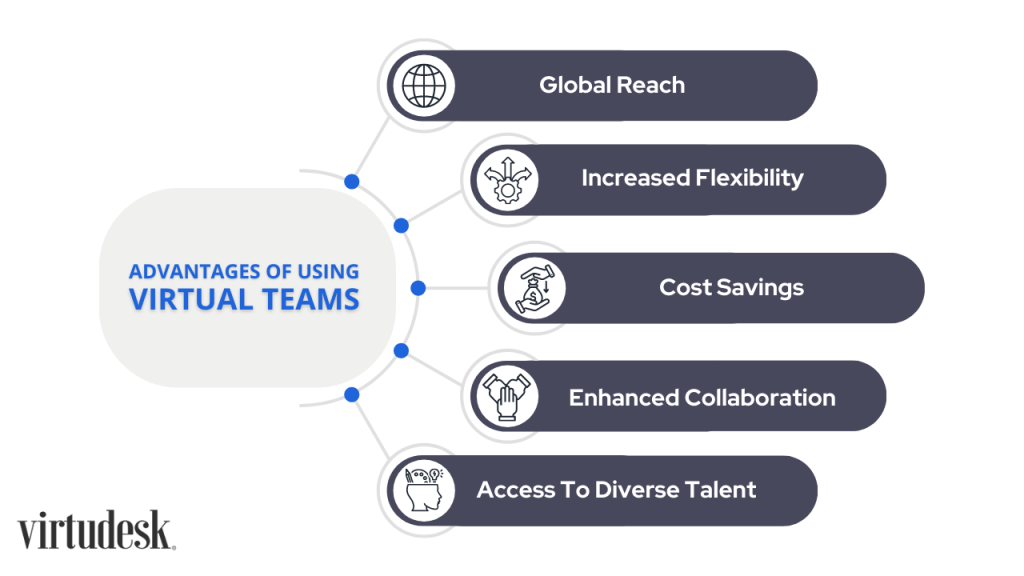Leveraging the Benefits of Virtual Teams for Your Organization
In the world of remote staffing, embracing virtual teams opens doors to unparalleled opportunities for enhancing your organization's potential and gaining a competitive edge. The multitude of advantages offered by virtual teams is simply remarkable.
When you choose virtual teams, you're opting for an exemplary solution that empowers your organization to tap into global talent, extend your reach, and optimize resource allocation. These teams are composed of talented individuals who collaborate seamlessly through remote communication, making technology their primary medium for success.
At Virtudesk, we’re thrilled to guide you through this transformative journey and help you unlock the true potential of remote staffing. So, let’s discuss everything you need to know to leverage the benefits of virtual teams for your organization!
And if you’re interested in setting up a virtual team but are unsure how we’re also here to help. Hiring virtual staff and creating remote teams will be as easy as three steps with us! We have you covered in many industries, so why not schedule a discovery call today?
What Are Virtual Teams?
Virtual teams encompass a collective of individuals who collaborate on a project or objective without being constrained by physical proximity. They work remotely and leverage digital technologies like video conferencing and chat applications, with members hailing from different countries, cultures, and backgrounds.
Essentially, the structure of virtual teams offers remarkable flexibility, surpassing that of traditional teams. This fosters heightened collaboration and seamless and swift communication among team members. It also provides unparalleled flexibility, allowing individuals to tailor their work schedules to their specific needs and preferences.

Tracing The Roots of Virtual Teams
The roots of virtual teams can be traced back to the advent of the Internet. In the late 1990s, companies recognized the potential of utilizing internet connectivity to bridge the gap between geographically dispersed employees. This facilitated collaborative endeavors, resource sharing, and remote project management.
Soon after, the rise of cloud computing in the early 2000s further facilitated the utilization of virtual teams. Cloud computing enabled companies to store their data and applications on remote servers, granting employees universal access from any location. This empowered companies to form virtual teams capable of seamless collaboration, resource sharing, and project management, regardless of physical boundaries.
Then, the late 2000s witnessed significant advancements in communication and collaboration tools, further empowering virtual teams. Platforms like Skype, Slack, and Microsoft Teams revolutionized team communication and collaboration, providing seamless channels to share documents, collaborate on projects, and manage tasks, irrespective of geographic dispersion.
In the present day, virtual teams continue to gain popularity as businesses embrace a globalized outlook. Enterprises recognize the potential of virtual teams to foster collaboration, enhance productivity, and tap into a diverse talent pool.
Advantages of Using Virtual Teams
Virtual teams present a myriad of advantages for organizations seeking to optimize their operations. Some benefits of leveraging virtual teams include:
Global Reach
Virtual teams offer organizations an exceptional advantage by tapping into a vast global talent pool, bringing together the finest minds from across the world. Geographical boundaries no longer limit your search for the perfect candidates – you can now hire the right people for the job, regardless of their location! This diversity of talent enhances creativity and brings in highly skilled individuals, contributing to a robust and dynamic team.
Beyond talent acquisition, virtual teams enable organizations to establish a presence in various countries and regions. This strategic expansion opens doors to new opportunities, allowing businesses to reach a broader customer base and connect with a more extensive audience. It also grants invaluable insights into local cultural norms and customs, empowering them to tailor their products and services for specific markets.
More importantly, virtual teams foster meaningful relationships between organizations and businesses in different countries. This enables businesses to leverage the expertise and knowledge of their foreign counterparts while gaining access to new markets and resources.
Increased Flexibility
Unlike traditional setups, virtual teams break free from the constraints of a physical office space, enabling employees to work from anywhere in the world, at any time. This exceptional flexibility equips organizations with the agility to swiftly adapt to market changes and cater to evolving customer demands.
Moreover, virtual teams possess the unique capability to scale up or down rapidly, precisely aligning with the dynamic needs of your business. This inherent agility ensures your organization remains competitive and responsive to any challenges or opportunities.

Cost Savings
Virtual teams offer remarkable cost-saving opportunities for organizations. By eliminating the need for physical office spaces, businesses can significantly reduce their operating costs, including expenses related to rent, utilities, and maintenance. This streamlined approach ensures your organization can allocate resources more efficiently, maximizing its financial potential.
Travel expenses can also be significantly reduced through virtual teams. With team members collaborating seamlessly from diverse locations, there is no need for frequent business travel. This not only saves costs associated with transportation and accommodation but also frees up valuable time for more productive endeavors.
Enhanced Collaboration
By assembling team members from different parts of the world, virtual teams create opportunities for collaboration that would otherwise be impossible. Through real-time communication, idea sharing, and collaborative project work, virtual teams facilitate synergy and collective excellence.
Access To Diverse Talent
By embracing virtual teams, organizations can tap into a larger talent pool that extends beyond their local area. This ensures they can identify and recruit the best individuals for each role, regardless of their geographical location.
Additionally, hiring remote workers enables organizations to save on recruitment and training costs, as they can onboard professionals from different countries without the need for costly relocation expenses. This cost-effective approach empowers businesses to build high-performing teams with exceptional expertise from across the globe.
What Are The Different Platforms/Tools For Virtual Teams?
Virtual teams have gained significant traction in today's globalized workplace, enabling organizations to seamlessly collaborate with colleagues across the globe. To harness the full potential of these teams, it is crucial to choose a platform that aligns with your unique needs and requirements.
Some popular tools and platforms for virtual teams are:
Microsoft Teams
Microsoft Teams is an all-in-one workspace designed to streamline operations and optimize workflows. Its integrated features include chat, voice and video conferencing, file sharing, and task management, empowering seamless collaboration among team members.
Built on the trusted Microsoft 365 platform, Teams ensures secure access to corporate data, applications, and services. It also features real-time collaboration and seamless integration with other Microsoft 365 applications like Outlook, Word, Excel, and PowerPoint.
Plus, with AI-driven features, Teams keeps your team connected and efficient. Bots automate everyday tasks, such as meeting scheduling and task management, while providing quick answers to questions and access to up-to-date information.
Slack
Slack offers an intuitive interface and powerful features to facilitate real-time communication and smooth collaboration. Tracking conversations, managing tasks, and sharing files becomes effortless with this invaluable tool in your arsenal.
Its customizable channels enable easy organization of conversations around specific topics, ensuring swift access to vital information. Additionally, Slack's wide range of integrations with popular applications like Google Drive, Zoom, and Asana enhances efficiency by granting users quick access to shared documents and resources.
Zoom
Zoom has recently gained immense popularity due to its user-friendly interface, robust feature set, and scalability. With features like screen sharing, whiteboarding, and file sharing, Zoom offers a comprehensive toolkit for effective collaboration. It enables seamless virtual meetings, webinars, and conferences with a capacity of up to 1,000 participants.
Moreover, Zoom ensures convenience and accessibility by allowing users to record and store meetings for future reference. Security is a top priority, and Zoom delivers with features like password protection, waiting rooms, and end-to-end encryption, guaranteeing the confidentiality and privacy of your meetings.
Consequently, Zoom's integration capabilities are noteworthy. It flawlessly integrates with popular applications like Slack, Salesforce, and Google Calendar, providing enhanced accessibility to data and fostering more efficient collaboration.
Asana
With its robust capabilities, Asana empowers teams to work more efficiently by organizing tasks, assigning responsibilities, and tracking progress. Teams can effortlessly create, assign, and set due dates for tasks while tracking progress every step of the way.
Additionally, Asana enables the setup of projects, task assignments to individuals, and progress monitoring. Teams can then customize workflows, assign tasks to multiple members, and attach files, ensuring a comprehensive workspace.
Seamless collaboration is further facilitated through Asana's integrated chat, comments, and @mentions, enabling real-time communication to ensure alignment and clarity among team members. The platform also offers convenient integrations with popular tools like Google Drive and Dropbox, providing a centralized hub for project and task management.
Moreover, Asana equips teams with powerful analytics tools to track and monitor progress. Teams can effortlessly monitor task completion rates, track progress over time, and gain valuable insights into team performance.
Google Workspace
With Google Workspace, your team gains seamless access to documents, spreadsheets, presentations, and more from any device, enabling productivity from virtually anywhere. This powerful suite encompasses a range of tools, empowering teams to stay organized, communicate swiftly, and collaborate effortlessly on projects.
The comprehensive suite includes Gmail, Calendar, Drive, Docs, Sheets, Slides, Meet, and more, all thoughtfully integrated to facilitate effective teamwork. Gmail provides a secure and reliable email service, while Calendar simplifies meeting coordination. Drive, a cloud-based storage system, ensures documents and files are accessible across devices.
Real-time collaboration also becomes effortless with Docs, Sheets, and Slides, empowering teams to work together seamlessly. Similarly, Meet, a video conferencing app, facilitates face-to-face communication, transcending geographical boundaries.
Challenges Of Virtual Teams
While virtual teams offer numerous advantages, it is essential to acknowledge and address the potential challenges that come with them. We understand the importance of staying informed, so let's explore these considerations together:
- Communication: With team members scattered across different locations, effective communication may face hurdles, leading to misunderstandings and delays. Utilizing suitable communication tools and establishing clear protocols can bridge these gaps.
- Time Management: The absence of a central office might raise concerns about tracking progress and meeting deadlines. Implementing efficient project management tools and setting well-defined milestones can ensure tasks are completed on schedule.
- Trust: Building trust in a virtual environment can be challenging due to limited face-to-face interaction. Encouraging regular virtual meetings, fostering an open and supportive atmosphere, and recognizing individual contributions can cultivate a cohesive team dynamic.
- Technology: As virtual teams heavily rely on technology, technical glitches can impede productivity, particularly in real-time collaboration scenarios. Having backup plans, technical support, and regular software updates can mitigate potential disruptions.
- Culture: Virtual teams often consist of diverse members with varying cultural backgrounds. Emphasizing cultural awareness, promoting inclusive practices, and facilitating team-building activities can foster understanding and harmony.
- Leadership: Successful virtual teams thrive under strong leadership and clear direction. Designating a capable leader who can provide guidance, facilitate communication, and foster collaboration will be instrumental in the team's success.
By acknowledging and proactively addressing these aspects, your virtual team can overcome challenges and unlock their full potential, driving productivity and achieving remarkable results.
Now, are you thinking of building your virtual team? See what we have to offer or browse our resources for support! Our expertise in remote staffing will support you in navigating these complexities, ensuring your virtual team's success.
How To Effectively Use And Manage Virtual Teams?
Virtual teams offer tremendous benefits for your organization, but effectively managing and communicating with them requires a unique set of skills. To ensure the success of your virtual teams, begin by selecting the most suitable platform and tools to meet your organization's specific needs.
Once you have chosen a platform, ensure that all team members are well-informed about its features and functionalities. Clear instructions, user guides, and tutorials will facilitate seamless adoption. Additionally, establish explicit communication expectations and guidelines, including response times and conflict resolution approaches.
In addition to communication, define and communicate the roles and responsibilities of each team member. This clarity will enhance task completion and foster a collective focus on shared objectives.
Lastly, provide regular feedback and recognition to team members. Regular check-ins and feedback sessions, coupled with rewards and recognition programs, will foster an environment where team members feel valued, appreciated, and motivated, thus promoting a positive team culture.
Want to learn more about effectively hiring your virtual staff? See our related articles:
- Finding The Right Virtual Assistant Company For Your Needs
- Avoiding Common Mistakes When Hiring A Virtual Data Entry Role
- The Essential Virtual Assistant Client Onboarding Checklist
Deciding The Best Platform According To Your Needs
To make the process easier for you, we recommend following these steps when choosing the right platform for your virtual team:
- Identify your team's needs: Consider your specific requirements and goals. This will help you make an informed decision that aligns with your virtual collaboration objectives.
- Evaluate platform features: Different platforms offer various features, so it's important to assess which ones are most important for your team. For complex projects, platforms like Asana or Microsoft Teams with robust task management features might be ideal. For seamless communication, platforms like Slack or Zoom could be a good fit.
- Consider ease of use: Choose a platform with a user-friendly interface that can be easily understood and adopted by all team members. Complicated platforms can hinder collaboration and cause frustration.
- Factor in cost: Different platforms have different pricing structures, so find one that strikes a balance between affordability and the necessary functionality for your team.
Maximize Your Organization's Potential With Virtual Teams
In today's competitive business landscape, harnessing the power of virtual teams is crucial to achieving success. By embracing virtual teams, your organization can tap into a global talent pool, access diverse skill sets, and unlock a myriad of benefits such as cost savings, enhanced collaboration, and increased flexibility.
At Virtudesk, we specialize in remote staffing solutions to help you navigate the world of virtual teams with ease. By leveraging the advantages of virtual teams and combining them with our expertise in remote staffing, your organization can maximize its potential and achieve remarkable success. Let’s help you get started!
Final Thoughts
In the realm of remote staffing, leveraging virtual teams is a game-changing strategy that empowers your organization to thrive and gain a competitive advantage. The array of advantages that virtual teams offer is truly remarkable.
By opting for virtual teams, you open doors to exceptional opportunities, such as harnessing global talent, expanding your organizational reach, and optimizing resource allocation. These teams consist of talented individuals who seamlessly collaborate through remote communication, leveraging technology as their primary driver for success.
Are you ready to take advantage of this? Venture into this transformative journey and let us help you unlock the full potential of remote staffing. Schedule a free discovery call with us today!
FAQs
Are virtual teams more effective?
Virtual teams can be more effective than traditional teams in certain situations. Virtual teams offer increased flexibility, global reach, and access to diverse talent. They can also be more efficient and productive because they are not limited by geographical boundaries.
Why are virtual teams not suitable for all situations?
Although virtual teams can be a great asset to an organization, they are not suitable for all situations. Virtual teams require a certain level of trust and collaboration between team members, and some tasks may require more face-to-face interaction.
What is the difference between remote and virtual work?
Remote and virtual work are often used interchangeably, but there are some key differences. Remote work typically refers to a situation where an individual works from home or a remote location, while virtual work refers to a situation where a team works together remotely.
Share this article
Meet our Most Trusted
Partners & Clients

Byron Lazine
Co-Founding Chief-of-Operations at BAM (Broke Agent Media)I’ve been using Virtual Assistants for years throughout all of my companies. Once we found Virtudesk the process got even easier and allowed us to scale out our hiring. Highly skilled and accountable professionals. 100% recommend!

Rebecca Julianna James
Realtor / Content CreatorBefore getting started with Virtudesk I had my doubts that they would find what I was looking for. I needed a very particular person to add to my team and let me tell you I am highly pleased! My virtual assistant Myril is the best! I am excited to grow my socialmedia accounts with her. Thank you Virtudesk!

Chelsea Erickson
Realtor La Belle RE GroupI am very happy with the assistance Virtudesk is providing for my real estate business. This is a newer position for my company and we are working through the creation and efficiency.

















